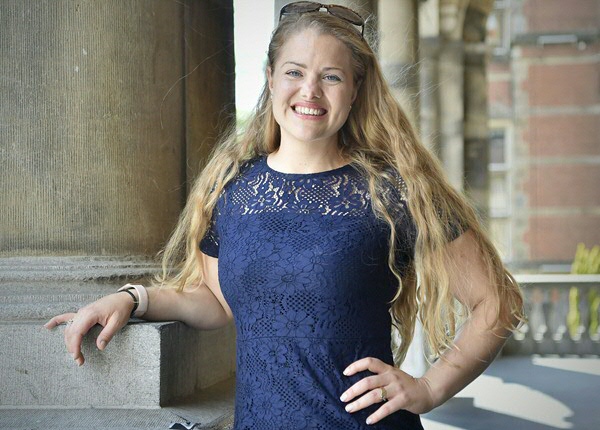From ‘closed’ science to Open Science

In January 2021, Vera Heininga was appointed Open Science coordinator and future programme leader of the upcoming Open Science programme of the University of Groningen. In 2017, Heininga defended her PhD thesis, which focused among other things on problems concerning the reproducibility of research and, together with her colleagues, she created the Open Science Community Groningen (OSCG). She explains what Open Science is.
Photos: Elmer Spaargaren
Open Science is a hot topic in the academic world. Could you briefly explain what it is all about?
Open Science is a more transparent way of conducting research. It is a worldwide movement based on openness, mutual learning and collaboration. Open Science relates to all teaching materials and the entire research cycle. It includes Open Educational Resources, pre-registering your confirmative hypotheses, sharing your data and code, uploading a preprint or publishing with Open Access.
How is this different from Open Access?
Open Access refers to the publication aspect of the research process, while Open Science is a pluriform term that covers the entire research cycle of planning, data collection, analysis, publication, outreach and evaluation. When an article appears with Open Access, it is accessible to everyone. If it is not with Open Access, only those who have a subscription to the relevant journal can access it. These are usually researchers working in a research-intensive organization like a university. This means that other potentially interested parties, such as policymakers, science journalists and researchers in other countries have no access to the research results. When results are not made available with Open Access, we as a society indirectly pay, via taxes, for publicly funded research of which we never see the results. This is a little strange, when you think about it.
Why is Open Science important in your opinion?
The past years have made it painfully clear that, in my scientific discipline, too many results cannot be reproduced (i.e. achieving the same result with a different sample). Without transparency, it is difficult to find out why research results cannot be replicated. Open Science makes it possible and easier to control and check scientific results. This is something that is, or should be, central to science. It is not for nothing that transparency is one of the five principles in the Dutch Code of Conduct for Academic Integrity.

Citizen science is one of the most appealing forms of Open Science. What does it involve?
Open Science is about being open towards other researchers, but also towards society as a whole. Citizen science goes one step further by not only openly communicating towards citizens, but also actively involving citizens in collecting data and analysing research. A beautiful example of this is the waddenplastic.nl web app, which was launched in 2019 by UG researchers when plastic waste was accidentally spread by the MSC Zoe cargo ship. With this web app, citizens are able to help map microplastic pollution in the Wadden Sea. Isn’t that great?
What are the potential benefits of Open Science for individual researchers?
There are lots! For example, Open Science improves visibility and impact for researchers. Studies show, for instance, that Open Access articles are more likely to be cited than non-Open Access articles. In addition, Open Science enhances research recognition by making it possible to cite not only publications but also datasets and software. Furthermore, there are now more and more Open Science awards and grants, including the annual UG Open Research Award and the recently launched NWO Open Science Fund.
Some interesting articles have also been published about the benefits of Open Science for individual researchers, for example ‘Five selfish reasons to work reproducibly’ by Florian Markowetz. According to Markowetz, transparent and reproducible work helps to prevent disasters like being unable to reproduce your own research, and it makes it easier to write scientific articles. In addition, it helps reviewers to see what researchers have exactly done, it guarantees continuity and it helps researchers to build a good reputation.
Are there any risks involved in making data freely available?
Absolutely. In making data freely available, the motto is always: as open as possible, and as closed as necessary. The greatest risk of ‘Open Data’, i.e. research data that is freely available to all, is that the privacy of participants in scientific research may be violated. If data is not sufficiently anonymized and/or too many details are included in the data, there is a risk that participants could be identified. This risk increases with a smaller research population. Think, for instance, of the oldest woman in the Netherlands donating her brain to Alzheimer’s research. The N=1 study that was published about her only listed her age and nationality but this was enough to identify her. It is important that researchers become aware of this risk and that they receive support in deciding which data to make public. It is also important to inform researchers about the available alternatives. For example, creating a look-alike dataset that can be used to approximately reproduce the results.
Why is it difficult to create a situation in which every researcher makes their workflow ‘open’?
The vast majority of Groningen researchers already, to some extent, apply Open Science principles to their academic work. The question is: are they being open enough? Habits, time pressure and the fear of being ‘scooped’ play an important role in this respect. Many researchers grew up in a world of ‘closed science’. It is difficult to break old habits, not to mention that researchers often work under high time pressure, which makes it more difficult to find time to explore the how and why of Open Science. Early-career researchers often do have time for it, and they find it easier to learn a different workflow from the start, but they sometimes face a lack of understanding and support from their supervisors. Another crucial element that plays a role in this context is the current rewards structure within universities. The recognition of and rewards for researchers are currently mostly focused on publishing as much as possible in prestigious journals, and the degree of transparency plays almost no role in this context. To ensure that every researcher makes their workflow as open as possible, it is essential that Open Science practices are better recognized and valued.
More information
- Vera Heininga
- Open Science Community Groningen
| Last modified: | 18 December 2023 08.59 a.m. |
More news
-
24 March 2025
UG 28th in World's Most International Universities 2025 rankings
The University of Groningen has been ranked 28th in the World's Most International Universities 2025 by Times Higher Education. With this, the UG leaves behind institutions such as MIT and Harvard. The 28th place marks an increase of five places: in...
-
11 March 2025
New: Sketch Engine, tool for language research
Sketch Engine is a tool for language research, which can also be used for text analysis or text mining.
-
05 March 2025
Women in Science
The UG celebrates International Women’s Day with a special photo series: Women in Science.
